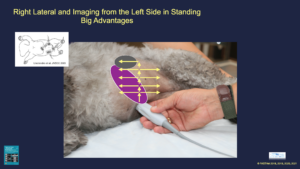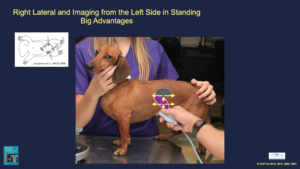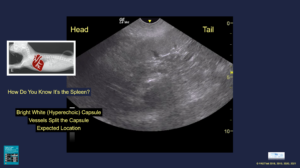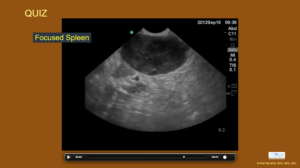
Over a decade ago we added the Focused Spleen to our AFAST® Protocol because splenic disease is common in our small animal patients, and as a result of the discovery of anaphylactic medically-treated hemoabdomen in dogs. Another FASTVet original for point-of-care ultrasound.
The AFAST® followed by the Focused Spleen. When your patient is in RIGHT lateral recumbency or standing, AFAST® is performed by imaging in the same standardized order of the DH view, followed by the SR view (least gravity-depender), the CC view and then ending at the most gravity-dependent view, now renamed more accurately, the Spleno-Intestino Umbilical (SI-U) view. The SI-U is performed at the level of the umbilicus and directing the scanning plane into the AFAST®’s most gravity-dependent pouch called the “Umbilical Pouch” followed by the Focused Spleen. These first 4 views make up the AFAST® abdominal fluid scoring system.
The Focused Spleen is performed by finding the spleen at or after the SI-U view. Then the spleen is followed by sliding and fanning cranially and caudally, sweeping along the body wall, and repeating the same sliding and fanning cranially and caudally until the spleen is tracked to the left kidney at the SR view. Fanning and changing the depth on the screen is important to interrogate the splenic parenchyma.
The Spleen is identified by the following:
- Its bright white hyperechoic capsule (unlike the liver whose capsule is not sonographically distinct in normalcy)
- Its vessels split the capsule (unlike the liver blood supply)
- Its expected anatomical location
Common Splenic Abnormalities:
- Any mass that deforms the capsule of the spleen is a serious finding
- Severe splenomegaly with a bright white hyperechoic Swiss cheese appearance R/O lymphoma
- Severe splenomegaly with a dark hypechoic Swiss cheese appearance R/O splenic torsion
Some other Quick Facts:
- The dog spleen should not extend to a small sized urinary bladder (consider the effects of sedation)
- The cat spleen should always be less than 10mm in thickness and never folds on itself
Our 2nd edition of our textbook Point-of-care Ultrasound Techniques, Wiley ©2021 has updates on the Focused Spleen and its common abnormalities that you may learn. Send your comments to Dr. Greg Lisciandro at LearnGlobalFAST@gmail.com
gl/GL 4-3-2023




